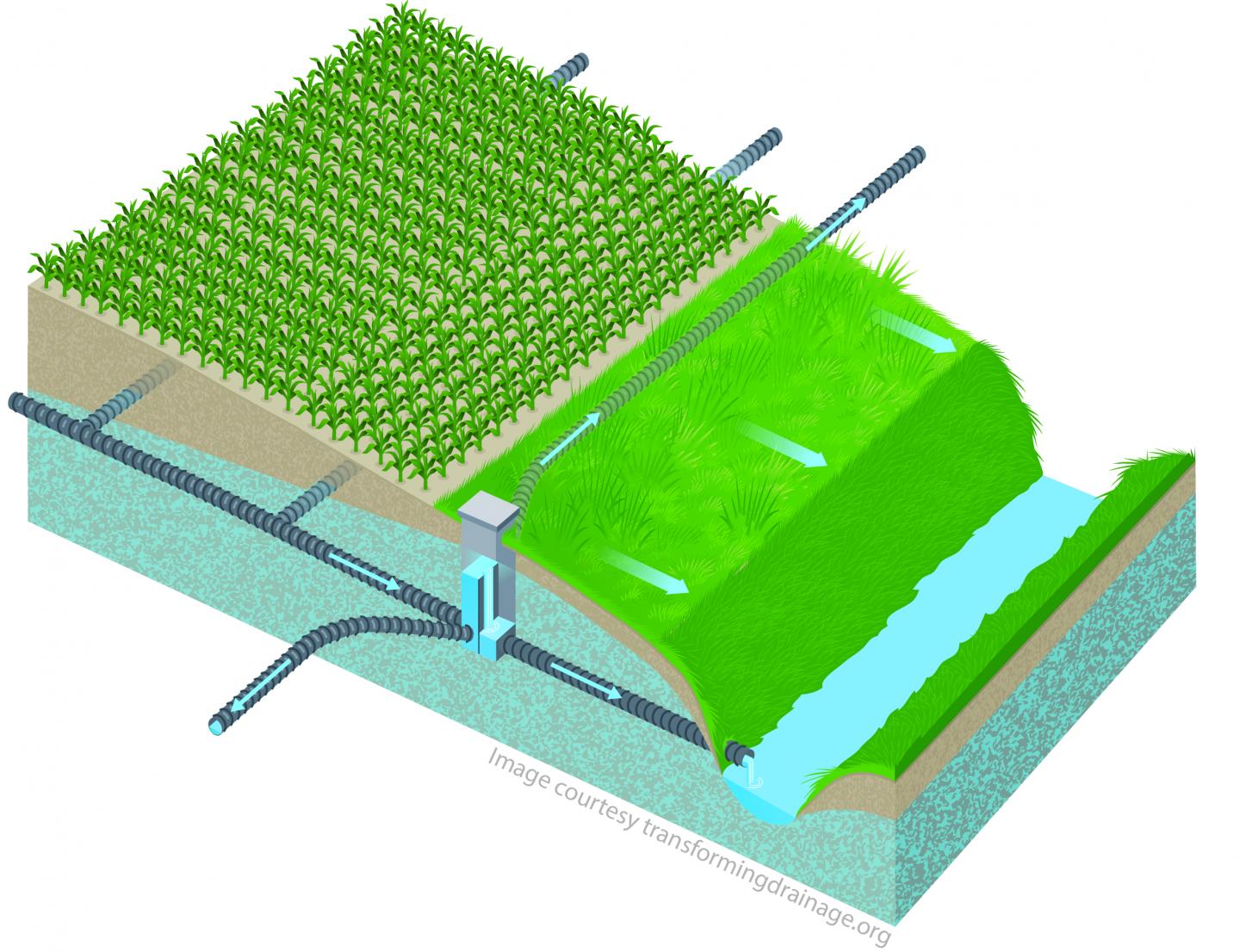
Credit: Transforming Drainage
URBANA, Ill. – Every summer, a “dead zone” forms in the Gulf of Mexico. Plumes of oxygen-robbing algae, fed by excess nitrogen coming in from the Mississippi River, kill off marine life and threaten the livelihoods of those who fish the Gulf. States bordering the Mississippi River are putting strategies in place to limit nitrogen from wastewater treatment plants, surface runoff, and agricultural fields. In a new study, University of Illinois scientists have estimated that a new conservation practice known as saturated buffers could reduce nitrogen from agricultural drainage by 5 to 10 percent.
“It might not sound like much, given that agricultural drainage only represents a portion of the nitrogen getting into the Mississippi. But 5 to 10 percent is pretty good for an inexpensive, passive system that farmers can put in and forget about,” says Reid Christianson, research assistant professor in the Department of Crop Sciences at U of I and co-author of the study, published in Agricultural and Environmental Letters.
Saturated buffers are vegetated strips of land – as little as 30 feet across – between tile-drained agricultural fields and waterways. Ordinarily, tile pipes carrying drainage water from the fields empty directly into ditches or streams. With a saturated buffer, the water is re-routed to a perforated pipe running below the surface and parallel to the stream. Water then flows through the soil of the saturated buffer into the stream. Along the way, soil microbes naturally remove up to 44 percent of the nitrogen.
“Saturated buffers don’t take a lot of land out of production, and are fairly inexpensive at $3,000 to $4,000 to treat drainage from a field-sized area (roughly 30 to 80 acres). Farmers have to be willing to not farm right up to the creek, but in terms of edge-of-field conservation practices, I think saturated buffers fit easily with farming and provide additional benefits like wildlife and pollinator habitat,” says Laura Christianson, assistant professor also in the crop sciences department and co-author of the study.
To arrive at their nitrogen reduction estimate, the Christiansons and doctoral student Janith Chandrasoma looked at publicly available digital maps of crop, soil, and stream types to estimate the total number of saturated buffers that could be installed across the Midwest: 248,000 to 360,000, which could treat up to 9.5 million acres of drained land. With other studies showing average nitrogen removal rates between 23 and 44 percent, this number of saturated buffers would reduce the total nitrogen load in agricultural drainage by 5 to 10 percent.
Laura says the approach required a lot of assumptions. For example, there are no satellite images or maps for tile drainage systems across the entire Midwest, so the researchers made the assumption that corn or soybeans fields on soil characterized as “poorly drained” were most likely tiled. However, Reid notes tile drainage systems are installed under many corn and soybean fields in the Midwest, not just poorly drained ones.
“Overall, our assumptions were relatively conservative. We probably underestimated our figures as a result,” he says.
Saturated buffers are a new conservation practice, with the first Natural Resources Conservation Service standard published in 2016. So far, they have not been adopted on anywhere near the scale shown possible in the Christiansons’ study. For example, Laura estimates there are probably fewer than 50 saturated buffers currently operating across the entire Midwest region.
“Adoption on the scale we estimated in the paper is likely a long way off,” she says, “but anything we can do to reduce nitrogen flowing to the Gulf, especially if it fits relatively easily with current on-farm management practices, warrants attention.”
###
The paper, “Saturated buffers: What is their potential impact across the US Midwest?” is published in Agricultural and Environmental Letters [DOI: 10.2134/ael2018.11.0059]. Authors include Janith Chandrasoma, Reid Christianson, and Laura Christianson, all from the Department of Crop Sciences in the College of Agricultural, Consumer and Environmental Sciences at U of I. The work was funded through the USDA Farm Service Agency.
Media Contact
Lauren Quinn
[email protected]
217-300-2435
Related Journal Article
http://dx.




